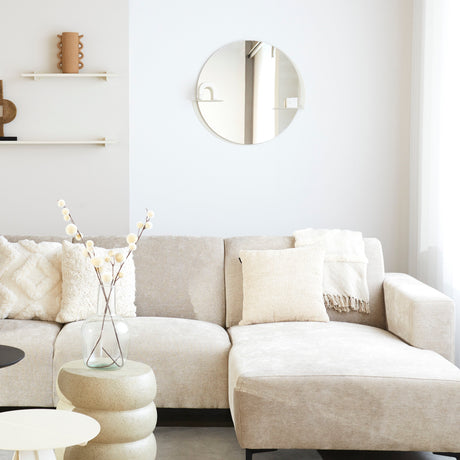Advantages |
Cons |
|
Doctrine |
+ Gives a more authentic feeling + Usually has a better finish than artificial leather + Durable + Flexible and elastic |
- Crack - Can entail a strong scent - Can get weaker over time - Can lose its original shine and color - Sensitive to stains. As a result, leather products are not recommended if you regularly have children on the floor. |
Artificial leather |
+ Animal friendly + Non-moisture + Easy (er) in maintenance + Easier to keep clean + Cheap |
- less sustainable - In some cases it may feel a bit 'cheaper' and plastic - Sensitive to wear - Holds a lot of heat (this is personal and can also be an advantage) |

Doctrine
#1 The creation of leather
Skins are sprinkled with salt to prevent spoilage. Everything except the dermis in which the hairs are stuck with roots, is thrown away. So much is removed in the tannery. The leather skin is then descaled again by rinsing it in a wooden barrel with water. The hair and fat are also dissolved. In addition, the last scraps of meat are removed, creating bare skin; the leather.
Leather skins are split in two, using the top layer, the nerlay layer, for the furniture industry. The bottom layer is a layer of split leather that is normally used for belts, shoes and bags. However, split leather is sometimes used for furniture.

The next phase is the descaling of the skins. This also happens in barrels. The skin is then stained, giving the leather a smooth structure. Again, salt is used to swell the skins. You can tidy up after swelling. After tanning, the skin is pulled over the entire width through a machine to get the thickness right everywhere.
When the skins go back into a barrel, dye is added. This means that the skins are dyed through and through. In this phase some fat is also added to the skins. After this process, the skins go into the drying tunnel and the skins are prepared for processing. Finally, a layer comes over the leather which protected against moisture and dirt. The latter layer is not applied to Aniline Leather. As a result, Aniline Leather seems like a beautiful product, but it is a disaster in maintenance.

#2 different types of leather
- Nap
The leather is equipped with a pigmented top layer, making the skin less visible. In terms of sustainability, a strong piece of leather. However, very sensitive to discoloration due to sunlight.
- Semi-Aniline leather
Equal to the leather, but the finishing layer is a bit thinner. This leather is closer to an original piece of leather.
- Full-aniline leather
Beautiful to see, but is not equipped with a protective layer. A matter of weeks and the skin is filthy and no longer to be repaired. Absolutely not recommended for furniture that is used intensively.
- Split leather
The lower skin layer of the leather. Because there is almost no grain drawing, it is provided with a covering paint layer. The Nerf is artificially printed in the leather. Split leather is less strong than the normal top layer leather.
- Pull-up leather
Grinding leather fibers that are pressed from a cloth under pressure on both sides. It often concerns split leather quality. The leather is painted in a number of layers and protected by a transparent film layer. The color can become lighter by folding the leather. By rubbing the leather under heat, the color appears again (pull-up).

Artificial leather
Artificial leather (also known as artificial leather, imitation leather, skai or PU) is an imitation of leather and therefore has different qualities than really leather. Artificial leather consists of a plastic that is applied to a textile carrier. A structure is then printed on the plastic that resembles the structure of a certain type of leather.
Artificial leather is widely used in the production of furniture such as seats or sofas, but also for many handbags, jackets or shoes, artificial leather is used. There is also artificial leather in different types. Nowadays there are many artificial learning that have a breathable effect and are difficult to distinguish from real leather. These are the artificial leathers made from polyurethane with a microporous structure. Artificial leather species that do not absorb moisture are often made from PVC or a combination of PCV and polyurethane.






















